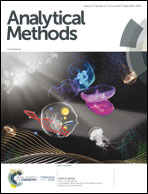A simple strategy for carboxylated MWNTs as a metal-free electrosensor for anchoring the RhB C![[double bond, length as m-dash]](https://www.rsc.org/images/entities/char_e001.gif) N group†
N group†
Abstract
Organic dye detection requires high sensitivity, low-cost equipment, simplified procedures, and real-time capabilities; thus, electrochemical methods are gradually emerging in this field instead of chromatography. However, much attention has been paid to toxic and complex metal or noble-metal hybrid materials for constructing electrochemical sensors, which is extremely limiting for practical applications. In this study, a metal-free electrocatalyst, MWNTs with carboxylic groups (MWNTs–COOH), was prepared through surface oxidation in a piranha solution and a simple hydrothermal treatment. The obtained MWNTs–COOH possessed superior hydrophilicity, increased conductivity and substantial active carbon or carboxylic group sites, as determined by characterization using Raman spectroscopy, contact angle measurements, electrochemical surface area analysis, and X-ray photoelectron spectroscopy. The above advantages enabled MWNTs–COOH to exhibit excellent electrochemical activities, with a satisfactory utilization for determining trace Rhodamine B (RhB), showing a lower calculated detection limitation of 2.66 nM and a wider linear range from 0.05 to 850 μM with outstanding specificity and reproducibility. Furthermore, it was found that the carboxyl group on the MWNTs would probably have triggered the electron redistribution and exposed more adjacent active carbon sites, which facilitate the electrocatalytic function to C![[double bond, length as m-dash]](https://www.rsc.org/images/entities/char_e001.gif) N on the RhB directly.
N on the RhB directly.
![Graphical abstract: A simple strategy for carboxylated MWNTs as a metal-free electrosensor for anchoring the RhB C [[double bond, length as m-dash]] N group](/en/Image/Get?imageInfo.ImageType=GA&imageInfo.ImageIdentifier.ManuscriptID=C9AY00744J&imageInfo.ImageIdentifier.Year=2019)
- This article is part of the themed collection: Analytical Methods Recent HOT articles


 Please wait while we load your content...
Please wait while we load your content...
![[double bond, length as m-dash]](https://www.rsc.org/images/entities/h2_char_e001.gif) N group
N group